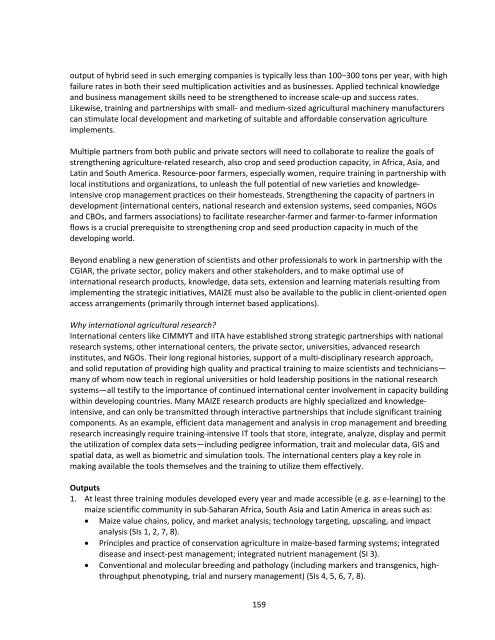Download - Maize
Download - Maize
Download - Maize
You also want an ePaper? Increase the reach of your titles
YUMPU automatically turns print PDFs into web optimized ePapers that Google loves.
output of hybrid seed in such emerging companies is typically less than 100–300 tons per year, with high<br />
failure rates in both their seed multiplication activities and as businesses. Applied technical knowledge<br />
and business management skills need to be strengthened to increase scale‐up and success rates.<br />
Likewise, training and partnerships with small‐ and medium‐sized agricultural machinery manufacturers<br />
can stimulate local development and marketing of suitable and affordable conservation agriculture<br />
implements.<br />
Multiple partners from both public and private sectors will need to collaborate to realize the goals of<br />
strengthening agriculture‐related research, also crop and seed production capacity, in Africa, Asia, and<br />
Latin and South America. Resource‐poor farmers, especially women, require training in partnership with<br />
local institutions and organizations, to unleash the full potential of new varieties and knowledgeintensive<br />
crop management practices on their homesteads. Strengthening the capacity of partners in<br />
development (international centers, national research and extension systems, seed companies, NGOs<br />
and CBOs, and farmers associations) to facilitate researcher‐farmer and farmer‐to‐farmer information<br />
flows is a crucial prerequisite to strengthening crop and seed production capacity in much of the<br />
developing world.<br />
Beyond enabling a new generation of scientists and other professionals to work in partnership with the<br />
CGIAR, the private sector, policy makers and other stakeholders, and to make optimal use of<br />
international research products, knowledge, data sets, extension and learning materials resulting from<br />
implementing the strategic initiatives, MAIZE must also be available to the public in client‐oriented open<br />
access arrangements (primarily through internet based applications).<br />
Why international agricultural research?<br />
International centers like CIMMYT and IITA have established strong strategic partnerships with national<br />
research systems, other international centers, the private sector, universities, advanced research<br />
institutes, and NGOs. Their long regional histories, support of a multi‐disciplinary research approach,<br />
and solid reputation of providing high quality and practical training to maize scientists and technicians—<br />
many of whom now teach in regional universities or hold leadership positions in the national research<br />
systems—all testify to the importance of continued international center involvement in capacity building<br />
within developing countries. Many MAIZE research products are highly specialized and knowledgeintensive,<br />
and can only be transmitted through interactive partnerships that include significant training<br />
components. As an example, efficient data management and analysis in crop management and breeding<br />
research increasingly require training‐intensive IT tools that store, integrate, analyze, display and permit<br />
the utilization of complex data sets—including pedigree information, trait and molecular data, GIS and<br />
spatial data, as well as biometric and simulation tools. The international centers play a key role in<br />
making available the tools themselves and the training to utilize them effectively.<br />
Outputs<br />
1. At least three training modules developed every year and made accessible (e.g. as e‐learning) to the<br />
maize scientific community in sub‐Saharan Africa, South Asia and Latin America in areas such as:<br />
<strong>Maize</strong> value chains, policy, and market analysis; technology targeting, upscaling, and impact<br />
analysis (SIs 1, 2, 7, 8).<br />
Principles and practice of conservation agriculture in maize‐based farming systems; integrated<br />
disease and insect‐pest management; integrated nutrient management (SI 3).<br />
Conventional and molecular breeding and pathology (including markers and transgenics, highthroughput<br />
phenotyping, trial and nursery management) (SIs 4, 5, 6, 7, 8).<br />
159

















